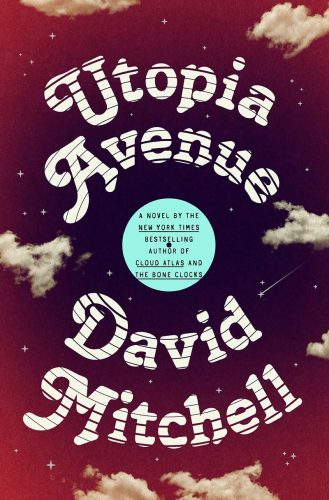Book Review: “Utopia Avenue” — A Broken Record?
By Clea Simon
These days, I worry that David Mitchell is losing touch with reality.
Utopia Avenue by David Mitchell. Random House, 592 pp., $30

Creating – making any kind of art – requires a form of split personality. Like a person suffering from delusions, the artist must experience that which isn’t – seeing the impossible. Hearing voices. That’s the source of the creativity. However, to shape these visions into a work of art the creative person must also be relentlessly pragmatic. The artist has to maintain a sense of what works in the real world and be willing and able to prune back the wild imaginings into something that the rest of humanity can make sense of.
These days, I worry that David Mitchell is losing touch with reality.
Mitchell’s new novel, Utopia Avenue, creates – or, really recreates – a world of intense imaginative abundance: the English music scene of the late ’60s. It opens, like a classic rags-to-riches tale, at a low point: Dean Moss, a bassist who has been kicked out of his band, is about to be robbed of his rent money – the first in a series of catastrophes that costs him his job and lands him homeless, in a bar, where he is spotted by a “bookish-looking” stranger, Levon Frankland, with dubious intentions.
Dean needn’t worry – yet. Levon’s aim is to take Dean to hear a failing blues band, headed by a has-been who is being propped up by a monster drummer, the decidedly working-class “Griff” Griffin, and an upper-class guitarist, Jason De Zoet, who happens to be a psychedelic genius. (Think of a white, half-Dutch Jimi Hendrix.) Before long, he’s put them together with a buxom – and recently heartbroken – folkie, Elf Holloway. The resulting band, Utopia Avenue, works, for a while, as does Mitchell’s novel. Fully inhabiting his young creatives, he follows them through the trials of life – love and sex, birth and death – as they come together as a band, with chapters about their individual histories neatly slipping in backstory and providing context as they drive around in their broken-down van, the Beast, rubbing the rough edges off each other on the way to fame.
The five – Levon plays a lesser role but has his revelations as well – are not alone. Drawing on Brian Eno’s idea of the “scenius,” Mitchell depicts a world where everything contributes to the creative ferment. Love and drugs in many combinations, sure, but also the presence of a community in which art and experimentation are encouraged. Cameos by stars from John Lennon and David Bowie to Brian Jones and Frank Zappa, as well as scenesters like the plaster casters, toggle between gimmicky and fun, as do the references to real-life incidents (notably the sexual encounter between Janis Joplin and Leonard Cohen in the Chelsea Hotel).
At times, Mitchell seems out of his league in describing music – a notoriously difficult pursuit. Although he usually avoids cliché (barring the expected “meteoric” guitar solos), his customary detailed and poetic visualizations tend toward word salad when trying to capture sound: That can be playful, as when “Elf’s Hammond gatecrashes the party, finds its feet, and dances a drunken jig.” At other times, as when Joni Mitchell (in another cameo) “pulses, dives, aches, swivels, regrets, consoles, avows” as she sings, the list of verbs cancels itself out.
There’s so much here – art in a changing world, class and culture differences – that for a long time this hefty novel works. But in what could be described as a fall into classic rock and roll excess, Mitchell can’t resist fiddling – throwing in so many extra fillips and turns that he ruins the beauty of the tune. In Mitchell’s case, the fussing comes largely in the form of references to his earlier works, an increasingly common occurrence in his books. The first time one of these references pops up it feels witty, a tip of the hat to the longtime reader already invested in what fans call the “Mitchellverse.” For me, it was the appearance of “The Cloud Atlas Sextet” by Robert Frobisher, a nod to the composer in Mitchell’s Cloud Atlas, that is discovered by De Zoet after a night with Mecca, an Astrid Kirchherr-like photographer. That Utopia’s DeZoet is related to the protagonist of Mitchell’s The Thousand Autumns of Jacob De Zoet (his great-great-great grandson, we eventually learn) is an equally unobtrusive nod to an earlier work. But before long references to these two books, as well as The Bone Clocks, Slade House, Black Swan Green, and Number Nine Dream, are taking over the plot, and undermining its coherence.

Author David Mitchell. Photo: Facebook
The problem is not in the allusions. It is that the narrative diverts to the styles of these earlier works, most notably the fantasy/horror of Bone Clocks and Slade House. De Zoet, we learn early on, appears to be on the autism spectrum. He works hard to translate emotions when in the presence of “Normals,” and both his awkwardness and his talent for masking draw on Mitchell’s writings about his own son. As the book progresses, we learn that the guitarist is also haunted by what appears at first to be an aural hallucination: a “knock knock” sound that may relate to his mother’s burial at sea. When that recurring sound is joined by apparent visual hallucinations – he sees the face of an Asian monk – it would seem that De Zoet’s undefined mental illness is worsening, a not unlikely development in a young artist in a drug-fueled scene. Rather than trust his character and letting this very real issue play out, however, Mitchell links the face to supernatural elements in the earlier books, tipping the book into science fiction.
Fantasy of this sort has become a Mitchell forte, and here serves as the kind of self-referential touch that may thrill diehard fans, as visual Easter eggs in superhero movies do for fans of the original comics. But for other readers – casual fans enjoying a historical rock-world novel or, god forbid, first-time readers unaware of Mitchell’s legacy – it’s maddening. Is this a book built on character? On individuals struggling to create art in the face of ordinary life crises? Or is it horror peopled by body-stealing demons? The two styles work at odds, and worse, and an extended detour involving generational regression via “mnemo-parallax” in pursuit of the 200-year-old monk Enomoto frankly reeks of self-indulgence, draining the human story line of its power. Although Mitchell pulls his narrative back for an emotionally appropriate conclusion (barring one reference to an apparent 10-year-old who claims to be 808), it’s too little too late. He’s lost the beat.
Some critics are already using the “broken record” metaphor for Utopia Avenue, largely because of its extended self-references. To these ears the novel plays more like a homemade mixtape. Everything we love about Mitchell is here – the wordplay, the imagery – but the tape’s been used too often. Old voices, fragments of former hits, keep breaking through, and what was charming the first time around has now become disruptive, interrupting what could have been a heady groove.
Clea Simon’s rock-world novel World Enough was named a “must read” by the Massachusetts Book Awards. Her next, Hold Me Down, will be published by Polis Books in September 2021. She can be reached at www.CleaSimon.com
